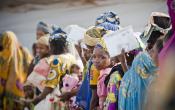Democratic Republic of the Congo Regional Office
Operation: Democratic Republic of the Congo Regional Office
Location
{"longitude":22,"latitude":-4,"zoom_level":5}
Latest update of camps and office locations 21 Nov 2016. By clicking on the icons on the map, additional information is displayed.
Key Figures
| 2018 planning figures | |
| 100% | of the urban refugees will have access to reproductive health and HIV services |
| 80% | of Central African refugee children will be enrolled in primary education |
| 80% | Congolese returnees (18-59 years) will have their own business and/or be self-employed for more than 12 months |
| 5,000 | community sanitary facilities/latrines will be constructed for South Sudanese refugees |
| 2,000 | Central African households will receive multipurpose cash grants or vouchers |
| 3 | schools will receive maintenance support |
| 2016 end-year results | |
| 90% | of identified Central African refugee children with specific needs were assisted |
| 80% | of primary school-aged Burundian refugee children were enrolled in primary education |
| 79% | of primary school-aged Central African refugee children were enrolled in primary education |
| 68% | of Burundian refugee households received sufficient basic and domestic items |
| 3,400 | Congolese returnees had access to adequate shelters |
| 1,000 | emergency shelters were provided to CAR refugee households |
| 430 | monitoring missions were undertaken to IDP locations, followed by advocacy interventions |
Latest Updates and Related Links
as of 12 December 2017
People of Concern
23%
Increase in
2016
2016
| 2016 | 3,321,847 |
| 2015 | 2,701,921 |
| 2014 | 3,619,785 |

[["Refugees",452887],["Asylum-seekers",3236],["IDPs",2232900],["Returned IDPs",619600],["Returned refugees",13224]]
Loading ...
Democratic Republic of the Congo Regional Office
< Back
2016
{"categories":[2013,2014,2015,2016,2017,2018],"budget":[196.62741826,196.1200685,207.82899884,209.71033616,234.31289884,181.096743668],"expenditure":[80.44026164,82.89793508,81.24654248,73.23818483,null,null]}
{"categories":[2013,2014,2015,2016,2017,2018],"p1":[84.29544165,71.90779198,91.41104086,103.12806996,136.71162641,102.914437591],"p2":[1.76370934,1.64748057,2.69677526,1.923405,1.94889796,1.285780285],"p3":[24.57256446,47.12909081,38.54665211,29.81920304,29.873246,18.143850296],"p4":[85.99570281,75.43570514,75.17453061,74.83965816,65.77912847,58.752675496]}
{"categories":[2013,2014,2015,2016,2017,2018],"p1":[48.3141246,50.09923907,57.35459999,58.9382084,null,null],"p2":[1.40268682,0.79246867,0.72133408,0.36397887,null,null],"p3":[12.22476921,16.65508797,10.2698795,3.24760875,null,null],"p4":[18.49868101,15.35113937,12.90072891,10.68838881,null,null]}
Loading ...
CHOOSE A YEAR
- 2014
- 2015
- 2016
- 2017
- 2018
Year-end Overview
Plan Overview
Working environment
The socio-political situation in the Democratic Republic of the Congo (DRC) has been relatively tense since the second part of 2016. President Kabila, who completed his second term in December 2016, has been authorized by the Constitutional Court to remain in power until a new president is elected.
The solving of political disagreements and elections will presumably benefit the work of the Government on a number of major issues of relevance to UNHCR, including the comprehensive solutions strategy for Rwandan refugees; durable solutions and adoption of a national law for IDPs and the accession to the two Statelessness Conventions of 1954 and 1961.
The MONUSCO operation is likely to further scale down in 2018, which could have an impact on joint efforts with the Congolese Army to contain or eradicate armed groups.
Government officials are committed to include issues related to UNHCR’s people of concern in major strategic tools, including the priority actions plan and the strategic document on growth and reduction of poverty. It is important to strengthen the role of the Government in IDP protection in order for them to take the lead.
Working in accordance with the Refugee Coordination Model, UNHCR will continue to lead and coordinate efforts for refugees, while drawing on the support of other Humanitarian Country Team members. In 2018 and 2019, under this model, UNHCR will advocate for durable solutions activities in areas where there are refugees, returnees and IDPs.
Key priorities
In 2018-2020, UNHCR will focus on the search for durable solutions and empowerment of refugees, while gradually reducing its assistance. Humanitarian assistance needs to be complemented by activities to protect and strengthen existing livelihoods, as well as strengthen the resilience of refugees.
UNHCR’s protection and solutions strategy is linked to the three key tiers of the UN System-Wide Strategy for the Protection of Civilians in DRC, including protection through political process, protection from physical violence and establishment of a protective environment.
In 2018, UNHCR will focus on:
- Undertaking innovative approaches, such as cash-based interventions. Refugees will build their own shelters, supported by material or cash assistance;
- Wherever security and other factors permit, settlement of people of concern among the local Congolese population will be facilitated;
- Rehabilitate health, education, water and sanitation and justice infrastructures in coordination with the Government and development partners;
- Enrol urban refugees to a health insurance for which they will contribute according to their degree of empowerment;
- Advocate for the inclusion of refugee children in the national education system. Integration of the education for refugees into the national school system;
- Implement income-generating activities (IGA) and microcredit projects to allow refugees to cover the costs of secondary education.







